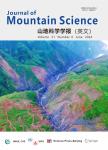Vegetation recovery after fire in mountain grasslands of Argentina
Vegetation recovery after fire in mountain grasslands of Argentina作者机构:Renewable Natural Resources Center of the Semi-Arid Zone(CERZOS)–CONICET-UNSBahia BiancaArgentina Department of BiologyBiochemistry and PharmacySouth National UniversityBahfa BiancaArgentina Argentine Institute of Oceanography(IADO)CONICET-UNSBahia BlancaArgentina
出 版 物:《Journal of Mountain Science》 (山地科学学报(英文))
年 卷 期:2020年第17卷第2期
页 面:373-383页
核心收录:
学科分类:0709[理学-地质学] 0819[工学-矿业工程] 07[理学] 0303[法学-社会学] 0818[工学-地质资源与地质工程] 0708[理学-地球物理学] 0705[理学-地理学] 0815[工学-水利工程] 0816[工学-测绘科学与技术] 0706[理学-大气科学] 0813[工学-建筑学] 0704[理学-天文学] 0833[工学-城乡规划学] 0713[理学-生态学] 0834[工学-风景园林学(可授工学、农学学位)]
基 金:supported by the ANPCyT under grant PICT 2014-0865 CONICET and Universidad Nacional del Sur from Argentina
主 题:Amelichloa caudata Forbs Grass Natural grassland Nassella trichotoma Piedmont valleys Shrubs Sierra de la Ventana Vegetation functional groups
摘 要:Fire is a natural disturbance occurring every few years in many grasslands ecosystems. However, since European colonization, fire has been highly reduced or even suppressed in Argentinean grasslands, fostering ignitable material accumulation. This has led to occasional catastrophic controldemanding fire events, extended for larger areas. The aims of this work are to study vegetation recovery and change after a non-natural fire event in mountain grasslands. The study area is located in the Ventania mountain system, mid-eastern Argentina. We studied vegetation recovery after fire(January 2014) in two different communities: grass-steppes(grasslands) and shrub-steppes(open low shrublands). We measured vegetation cover, species richness and bare ground percentage in burned and unburned areas 1, 4, 8, 11 and 23 months after fire. Vegetation surveys were also performed at the end of the growing season(December) 11 and 23 months after fire. Data were analyzed using regression analysis, ANOVA and multivariate analysis(NMS, PERMANOVA). Both communities increased their vegetation cover at the same rate, without differences between burned and unburned areas after two years. Species richness was higher in shrublands and their recovery was alsofaster than in grasslands. Considering functional composition, besides transient changes during the first year after fire, there were no differences in abundance of different functional vegetation groups two years after fire. At the same time, shrublands showed no differences in species composition, while grasslands had a different species composition in burned and unburned plots. Also, burned grassland showed a higher species richness than unburned grassland. Data shown mountain vegetation in Pampas grassland is adapted to fire, recovering cover and richness rapidly after fire and thus reducing soil erosion risks. Vegetation in mountain Pampas seems to be well adapted to fire, but in grasslands species composition has changed due to fire.



